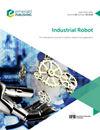基于可靠动态辨识的定制化工业机器人多目标轨迹优化规划,提高控制精度
IF 2.5
4区 计算机科学
Q3 ENGINEERING, INDUSTRIAL
Industrial Robot-The International Journal of Robotics Research and Application
Pub Date : 2022-06-20
DOI:10.1108/ir-12-2021-0301
引用次数: 1
摘要
目的通过提出的多目标轨迹优化方法,提高定制工业机器人的控制精度、能效和生产率。为了获得最优运动状态下机器人关节的精确动态匹配力矩,提出了一种基于参数辨识方法的改进动力学模型。本文提出了一种新的多目标优化方法,以使机器人轨迹的时间和能量消耗最小。首先,提出了一种可靠的动态参数辨识方法,以获得关节力矩,并用于制定归一化能量优化函数和动态约束。然后,基于二阶锥规划和龙格-库塔离散方法,将目标函数转化为松弛约束,求解最优轨迹变量,降低求解复杂度;通过仿真和实际定制机器人进行了大量的实验。结果表明,与现有优化研究中使用的简化模型相比,该模型预测的关节转矩精度提高了28.79% ~ 79.05%。同时,在相同的求解效率下,与现有的优化轨迹和多项式轨迹相比,所提出的优化轨迹消耗的时间更短,能量更少。提出了一种基于动态识别的时间-能量最优轨迹规划方法。现有的优化方法大多忽略了动态模型可靠性对能效优化的影响。提出了一种新的参数辨识方法和完整的动态转矩模型。动态匹配力矩实验结果验证了该模型能显著提高机器人最优运动的控制精度。本文章由计算机程序翻译,如有差异,请以英文原文为准。
Multi-objective optimal trajectory planning of customized industrial robot based on reliable dynamic identification for improving control accuracy
Purpose
The purpose of this paper is to enhance control accuracy, energy efficiency and productivity of customized industrial robots by the proposed multi-objective trajectory optimization approach. To obtain accurate dynamic matching torques of the robot joints with optimal motion, an improved dynamic model built by a novel parameter identification method has been proposed.
Design/methodology/approach
This paper proposes a novel multi-objective optimal approach to minimize the time and energy consumption of robot trajectory. First, the authors develop a reliable dynamic parameters identification method to obtain joint torques for formulating the normalized energy optimization function and dynamic constraints. Then, optimal trajectory variables are solved by converting the objective function into relaxation constraints based on second-order cone programming and Runge–Kutta discrete method to reduce the solving complexity.
Findings
Extensive experiments via simulation and in real customized robots are conducted. The results of this paper illustrate that the accuracy of joint torque predicted by the proposed model increases by 28.79% to 79.05% over the simplified models used in existing optimization studies. Meanwhile, under the same solving efficiency, the proposed optimization trajectory consumes a shorter time and less energy compared with the existing optimization ones and the polynomial trajectory.
Originality/value
A novel time-energy consumption optimal trajectory planning method based on dynamic identification is proposed. Most existing optimization methods neglect the effect of dynamic model reliability on energy efficiency optimization. A novel parameter identification approach and a complete dynamic torque model are proposed. Experimental results of dynamic matching torques verify that the control accuracy of optimal robot motion can be significantly improved by the proposed model.
求助全文
通过发布文献求助,成功后即可免费获取论文全文。
去求助
来源期刊
CiteScore
4.50
自引率
16.70%
发文量
86
审稿时长
5.7 months
期刊介绍:
Industrial Robot publishes peer reviewed research articles, technology reviews and specially commissioned case studies. Each issue includes high quality content covering all aspects of robotic technology, and reflecting the most interesting and strategically important research and development activities from around the world.
The journal’s policy of not publishing work that has only been tested in simulation means that only the very best and most practical research articles are included. This ensures that the material that is published has real relevance and value for commercial manufacturing and research organizations. Industrial Robot''s coverage includes, but is not restricted to:
Automatic assembly
Flexible manufacturing
Programming optimisation
Simulation and offline programming
Service robots
Autonomous robots
Swarm intelligence
Humanoid robots
Prosthetics and exoskeletons
Machine intelligence
Military robots
Underwater and aerial robots
Cooperative robots
Flexible grippers and tactile sensing
Robot vision
Teleoperation
Mobile robots
Search and rescue robots
Robot welding
Collision avoidance
Robotic machining
Surgical robots
Call for Papers 2020
AI for Autonomous Unmanned Systems
Agricultural Robot
Brain-Computer Interfaces for Human-Robot Interaction
Cooperative Robots
Robots for Environmental Monitoring
Rehabilitation Robots
Wearable Robotics/Exoskeletons.

 求助内容:
求助内容: 应助结果提醒方式:
应助结果提醒方式:


